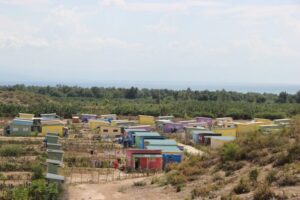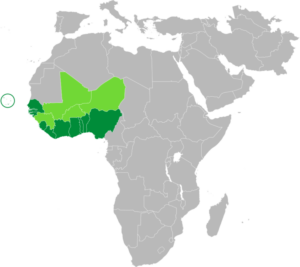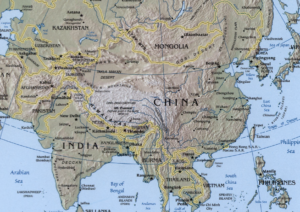- The Plan aims to modernize railway infrastructure, implement efficiency in services and attract private investment;
- The Chinese Belt and Road Initiative (new Silk Road) plays a crucial role in financing railway projects in Africa;
- Rail interconnection in East Africa not only stimulates economic growth but also plays a crucial role in promoting geopolitical stability.
The East African Railway Master Plan emerges as a strategic initiative aimed at transforming railway networks in the region, covering several East African countries.
By connecting these nations, the plan seeks to not only boost economic growth, but also strengthen regional integration and reduce dependence on road transport, as well as strengthen the region geopolitically.

What is the East African Railway Master Plan?
The East African Railway Master Plan is an initiative aimed at revitalizing and expanding existing railway networks in the East African region. This plan aims to provide a strategic vision for the development of the railway sector over the next 25 years. Here is some information about the plan:
Key Countries Involved:
- Tanzania
- Kenya
- Uganda
- Rwanda
- Burundi
- South Sudan
- Ethiopia (potentially)
Major Lines Already Built:
Standard gauge railway in the northern corridor, connecting Mombasa (Kenya) to Malaba (shared town between Kenya and Uganda), with a spur to Juba (South Sudan), Kigali (Rwanda), and eventually Bujumbura (Burundi).
Major Lines Under Construction:
Expansion of the standard gauge railway in the northern corridor, with the Kenyan section already under construction.
Major Planned or Planning Lines:
Additional connections to South Sudan, Ethiopia – ongoing negotiations –, and other routes aimed at strengthening regional integration and trade.
Overall Objectives of the Plan:
- Infrastructure Upgrade: Modernize and enhance existing railway structures to meet growing demands and keep pace with technological advances.
- Efficient Service Management: Adopt more efficient operational practices to ensure agile and responsive railway management to user needs.
- Attract Private Sector Investments: Develop attractive business opportunities to motivate private sector investments, boosting project financing and viability.
- Regional Integration: Strengthen collaboration between countries, facilitating cross-border railway connections that drive regional integration and joint development.
- Reduction of Road Transport Dependency: Aim to reduce dependence on road transport, favoring the use of railways, considered more efficient and sustainable.
The Role of the Chinese “Belt and Road” in Financing the East African Railway Master Plan
The Belt and Road Initiative (BRI), known as the Chinese “Silk Road,” plays a crucial role in financially supporting infrastructure projects, including the ambitious East African Railway Master Plan.
In this context, the BRI, a global infrastructure approach promoted by China, aims to foster collaboration between nations along land and maritime routes, stimulating trade, facilitating investments, and promoting improvements in connectivity infrastructure.
In the African scenario, the BRI emerges as a significant financier of comprehensive projects, including not only railways but also highways, ports, and other initiatives.
Chinese commitment stands out, especially in promoting the expansion and modernization of railway networks on the continent, offering loans and investments to key participants like Kenya, Tanzania, and Uganda.
This financial influx, beyond representing an opportunity for railway development, also brings the prospect of strengthening regional integration and facilitating cross-border transportation, consolidating economic ties among the involved nations.
Negotiations and bilateral agreements between African countries and China play an essential role in this process, establishing the foundations for the necessary funding and technical assistance for the successful implementation of these strategic projects.
Challenges Encountered in the Implementation of the East African Railway Master Plan
The implementation of the plan also faces challenges and has received international criticism throughout its implementation, including:
- Environmental Impact: Large infrastructure projects like railways can have significant environmental impacts, including deforestation, changes in local ecosystems, and potential pollution. Environmental concerns can result in resistance from local communities and global concerns.
- Construction Delays: Large-scale railway infrastructure projects often face construction delays due to various reasons such as funding issues, technical challenges, bureaucracy, and territorial disputes.
- Insufficient Financial Returns: The financial viability of some projects can be problematic. If the economic benefits generated by the railway are not sufficient to cover construction and operational costs, it can lead to financial difficulties for the involved countries, affecting the long-term sustainability of the project.
- Financial Dependence on China: In some cases, infrastructure projects’ implementation is funded through loans from China, leading to a situation where part of the project-generated resources is used to repay debts to China. This can create financial dependence and raise questions about the economic sovereignty of the involved countries, the so-called “debt trap.”
- Participants’ Indebtedness: Excessive indebtedness of participating countries is a significant concern. If loan terms are unfavorable or projects do not generate sufficient revenue, countries may face difficulties in meeting their financial obligations, leading to a situation of excessive debt.
- Political and Social Challenges: The implementation of infrastructure projects often faces political and social challenges, including resistance from local communities, territorial disputes, political instability, and changes in government leadership.
- Transparency and Governance: Issues related to transparency and governance in large-scale projects can raise concerns about corruption and improper practices. Lack of transparency in agreements and contracts can generate distrust and controversies.
- Technical and Logistical Challenges: Railway projects face technical and logistical challenges, such as the need to overcome difficult terrains, ensure proper maintenance, and deal with operational issues.
In summary, the implementation of the East African Railway Master Plan presents benefits and challenges that address environmental issues to geopolitical and economic dynamics. Therefore, it is crucial to emphasize the need for balanced and sustainable approaches to ensure the long-term success of these endeavors.
The Economic and Geopolitical Importance of Connecting East Africa with Railway Lines
The interconnection of East Africa through railway lines holds significant economic and geopolitical importance for the region. Some of these benefits include:
Economic Importance:
- Boosting Economic Growth: Infrastructure development, such as railway lines, is considered an investment that can boost economic growth. Improved connectivity promotes trade, facilitates the transportation of goods, and reduces logistical costs, benefiting economic activity.
- Facilitating Trade: Efficient railway lines facilitate the transportation of goods between regions, promoting intra and inter-regional trade. This is vital for the development of economic sectors and access to broader markets.
- Stimulating Regional Development: Railway interconnection can stimulate development in previously isolated areas, promoting investments in sectors such as agriculture, mining, and manufacturing.
- Job Creation and Capacity Building: Large-scale railway projects often result in the creation of local jobs, both during construction and in ongoing operation. Additionally, they may require the training of local workers in specialized skills.
- Development of Urban Centers: Railway connectivity can boost the development of urban centers along the routes, creating economic hubs and attracting investments in complementary infrastructure.
Geopolitical Importance:
- Regional Integration: Railway interconnection promotes regional integration by facilitating the movement of people and goods between neighboring countries. This strengthens economic and cultural ties, reducing barriers and promoting greater regional cohesion.
- Reduction of Tensions and Conflicts: Economic and social connectivity can contribute to the reduction of tensions and conflicts between nations, creating positive interdependence. The sharing of infrastructure, such as railways, can reduce the chances of territorial conflicts.
- Strengthening Regional and Global Influence: Countries with developed infrastructure have greater regional and global influence. The ability to play a crucial role in the transportation of goods and people contributes to the projection of power and political influence.
- Attraction of Foreign Investments: The presence of efficient transportation infrastructure can attract foreign investments, boosting economic growth and strengthening the position of countries on the international stage.
- Sustainable Development: Sustainable transportation infrastructure, such as railways, contributes to sustainable development by reducing carbon emissions associated with road transport and increasing resource efficiency.
In summary, railway integration in East Africa not only drives economic development but also plays a fundamental role in potentially promoting geopolitical stability.
By uniting efforts, countries in the region can emerge as a cohesive and influential voice, gaining greater weight in international organizations such as the United Nations, for example.
This strengthened unity also contributes to the formation of a more robust and impactful region in the global context.








Be First to Comment